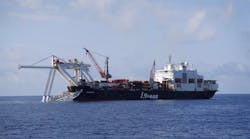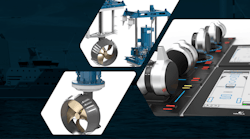A multi-service semisubmersible developed by Davie Industries of Quebec is being developed for a growing international market in well inter-vention, completion, and pipelay capa-bilities for deepwater operations. The Amequest is depth rated for 10,000 ft and will be capable of storage, testing, and subsea installation of wet trees.
The proposed vessel can perform manifold and umbilical installation with a 360-ton outboard deepwater heavy lift crane or with a 650-ton multi-purpose tower. And it has hotel capacity for up to 150. This new design, Amequest, will serve what Davie considers a critical niche in the deepwater multi-service market.
This dynamically positioned semisubmersible is designed to accommodate two remotely operated vehicles (ROV), one aft and one from the moonpool. The vessel's two-tier deck provides the strength to accommodate a moonpool that measures 8 meters by 24 meters, with an environment-protected testing and storage setback area for up to two subsea trees. The Amequest is designed with a variable deckload of more than 4,000 metric tons and can mobilize for extended voyages with loading in excess of 3,100 metric tons with sustained speed of nine knots.
The Amequest will perform field decommissioning and abandonment as well as initial well casing installation. The vessel is designed to perform intervention activities, umbilical installation, hydraulic injection/supply installation, and flowline and riser installation.
Intervention market
There are very few multi-service vessels available on the market today, and with rig utilization creeping toward 100%, it seems likely that the available fleet of multi-purpose monohull and semisubmersible units will find no shortage of work.
Cal Dive International has invested in two such rigs, the Uncle John, which the company calls the cornerstone to its deepwater strategy, and the Q 4000. Unlike the Amequest, the Uncle John is rated for use in the North Sea. The vessel's saturation diving complex can house and support 16 divers allowing round-the-clock, split level diving operations to 1,000 ft. It has a built-in Tritontrademark XL ROV for support to 6,600 ft. The main deck has a large working area that can handle special project deckloads of 460 metric tons, and the rig is equipped to assist in well completion services, which enables more exploratory and development wells to be drilled.
Cal Dive's other multi-service vessel, the Q4000, also has a significant range of capabilities. The vessel has a large work deck capable of supporting 4,000 tons of variable deckload and can perform a broad range of intervention and construction activities. Its specialty is thru-tubing, performing well intervention tasks on a live deepwater subsea well including slick line, electric line, and coil tubing interventions.
Some have questioned the need for the multiple capabilities of a multi-purpose vessel in the absence of drilling capability. But apparently a real need for the Amequest's capabilities has risen, particularly in wet tree installation. In the first week of May 2001, five projects in the Gulf of Mexico alone were awaiting tree installation - a total of eight trees.
More trees in future
If current predictions are accurate, a critical need for the Amequest's subsea installation capabilities is possible in the near future. More than 623 new trees will be installed in North America over the next eight and a half years. With more than 80% of the worldwide semisubmersible fleet being utilized for drilling, the Amequest's installation capabilities will become valuable when other work needs to be completed.
With the development of these advanced multi-service rigs, the industry is seeing a move toward cost-effective alternatives to using drilling rigs to perform related exploration and development activities. By using the specialized capabilities designed into the new vessels, drillers will be better able to maximize drilling rig use, an objective that will become increasingly more important as fewer and fewer rigs are available for drilling. Davie says that ongoing discussions could lead to construction of the Amequest in Davie's Quebec yard.







